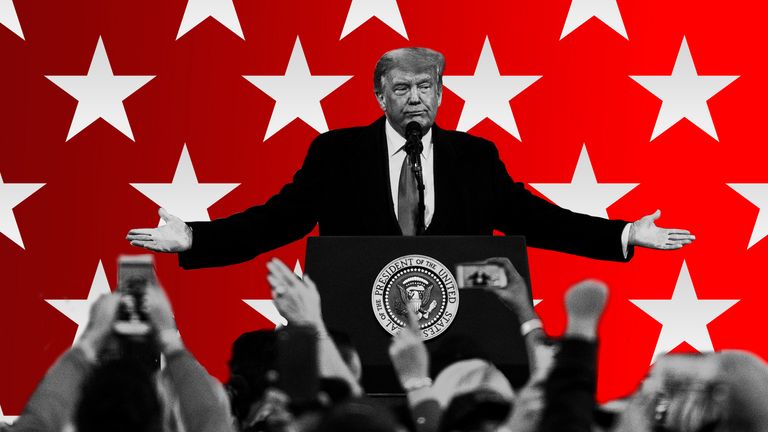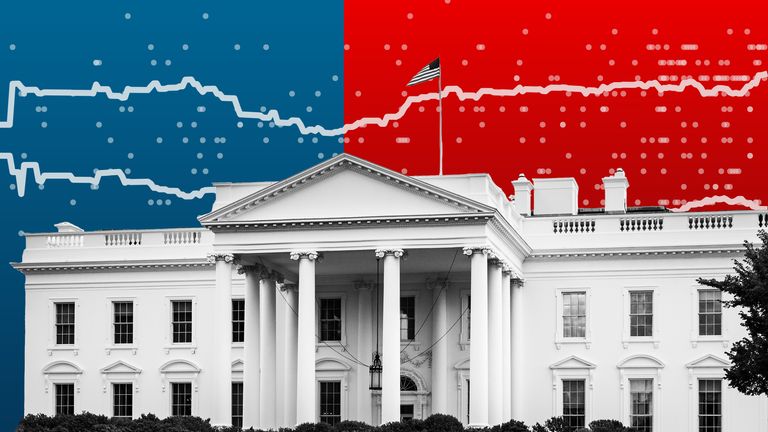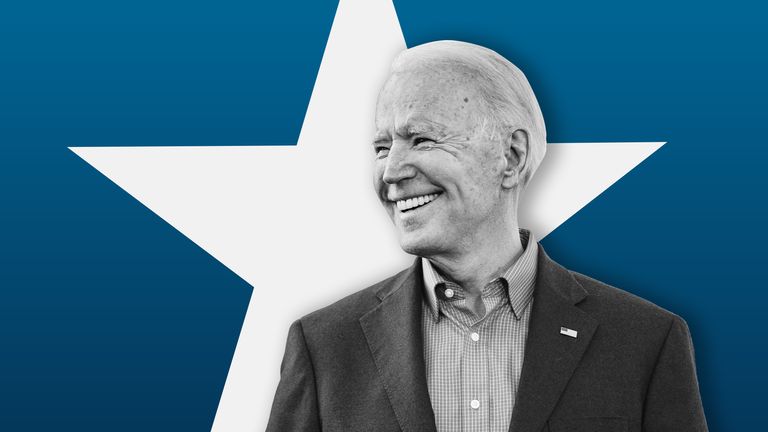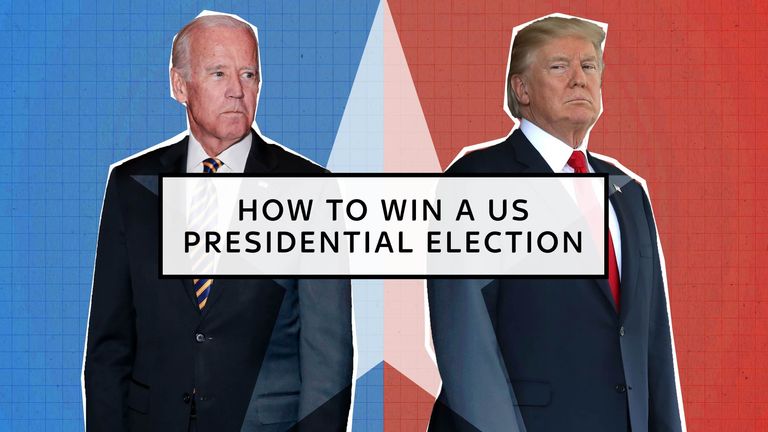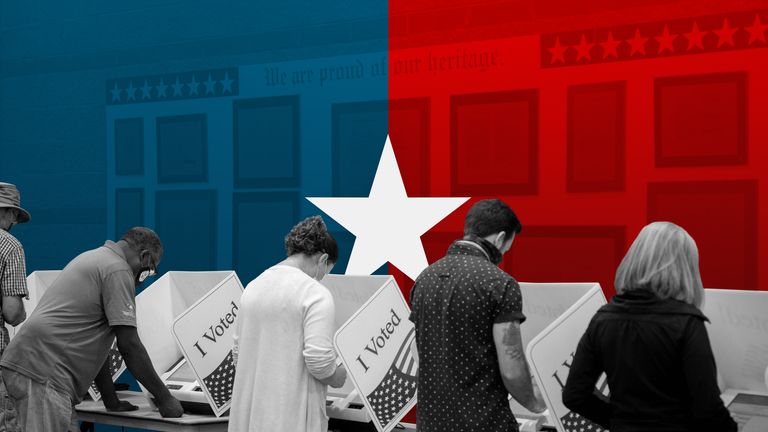US Election 2020: The paths to power for Biden and Trump
The polls have consistently put Joe Biden significantly ahead of Donald Trump at state and national level – but how could Trump still win?
Have the pollsters got it all wrong again? What does Biden need to do? Is chat about a landslide crazy talk? Will we even get a result on the night? Or just weeks, maybe months of legal dispute?
I’ve been speaking to lots of voters, pollsters and analysts to try and answer those questions.
A Trump win?
It’s absolutely possible, but his path is narrow. He needs to hold on to all the states he did in 2016, and that is no easy feat for an incumbent president. If he loses a state like Florida or Pennsylvania, with a big haul of electoral votes, he’d have to win over a lot of smaller states – again, that’s very tricky to do.
There are three key things that make the race harder for him this year:
- Demographics – a broader more diverse electorate of black and Latino voters who lean Democrat
- No real third-party candidates to dent Mr Biden’s reach in key states
- An opponent who doesn’t have the likeability issue Hillary Clinton did.
The voters that could help Trump win
If the majority of white voters go for Mr Trump and turnout rises significantly among them, but doesn’t in other groups, he has a path.
He also seems to be doing slightly better with Black and Latino voters than before – that will help him, but it means nothing if he haemorrhages a whole load of white suburban women voters.
If he wins, it may well be down to six factors:
- A better ground game, with more door-knocking than Joe Biden
- Poor Black voter turnout for the Democrats
- Underestimating the “shy” voter again – those who don’t openly admit to backing Mr Trump
- Big turnout in less populous states
- Registering more voters than the Democrats
- By not losing ground with Latino voters, and maybe even gaining some
Can we trust the polls?
In 2016, pollsters failed to account for white non-college-educated voters and thus a big part of Mr Trump’s appeal, but they tell me they’re confident they’ve addressed that issue in their approaches.
Most will tell you there is still a three-point margin of error in state and national polls. The difference between Joe Biden and Hillary Clinton is he has wider more consistent leads.
What does Biden need to do to win?
Small improvements, not a political earthquake.
He can win by picking up voters who went for a third party. By winning over some, but not loads of suburban women. Picking up older voters – especially those affected by COVID-19. And by getting college educated and white working-class voters who Mrs Clinton lost. The polls say he is doing all of that.
We’re taking about small margins in key battlegrounds: in fact if Biden gets just 1% of white swing voters, he would flip four states and capture 307 electoral votes – far more than the 270 he needs. If he gets black voters to vote like they did in 2012, he could also flip three states and win.
Is a landslide really possible?
Yes, but you won’t hear anyone in the Biden camp use the L word. They keep talking about it being a tight race.
They’ve all got what Mr Obama’s former chief strategist called “Post Polling Traumatic Stress Disorder” from 2016. They can’t afford for voters to sit this out, and know whatever the polls say, many more Republicans will vote on election day.
What do the campaign travel schedules tell us?
Mr Biden and his surrogates are going to historically out of reach places like Texas and Georgia – that shows confidence (it may prove too much of it).
Hillary had a disastrous moonshot strategy whilst she ignored her crumbling so-called “blue wall” in the Rust Belt. He is also though going to places like Nebraska and Maine which tells us that his team are also trying to prepare themselves for a tie.
Donald Trump isn’t going for long shots. He’s focused on lots of visits to the states he won in. If he secures them it’s enough, but the margins were slim, so he’s not taking anything for granted.
Can we deduce anything from early voting?
In short, no. It tells us that turnout should be high, but making inferences about Mr Trump or Mr Biden’s popularity from numbers isn’t wise. More Republicans will vote on election day than by mail and we have no idea what election day might really look like.
Will we get a result on the night?
It’s not impossible. A landslide either way would obviously make things clear. If Mr Trump starts significantly trailing in key places like Florida and Arizona, the political math as they say here could become insurmountable.
But the race could be very tight and much tighter than the polls suggest.
Lots of the battleground states won’t have decisive results on the night so delays are highly possible. Each team are legalled up, with hundreds of cases already going through the courts. Pennsylvania, so key, could take days.
In 2000, the Gore/Bush contested election went all the way to the Supreme Court. It could again and now Conservatives have the advantage of a 6-3 majority there.
Where to look for clues about the result?
Keep an eye on Maricopa, Arizona and Pinellas, Florida for signs of where the Latino vote is going. Pinellas has also picked the president since 1980. Now it’s a melting pot.
Look at Sumpter, Florida, for early votes and an indication of whether there is or isn’t a “grey revolt” against Mr Trump.
Look out for Macomb, Michigan, for a sense of where the socially conservative working-class white vote might lean.
If you want to keep a check on how Mr Biden is fairing in contested suburbs, Bucks County, Pennsylvania, is a good barometer, and look to Westmoreland to see if Trump’s been able to build on his success four years ago.
As for Black voters, watch Milwaukee, Detroit and Philadelphia to see if Mr Biden has been able to do better than Mrs Clinton fared.
Source: Read Full Article
